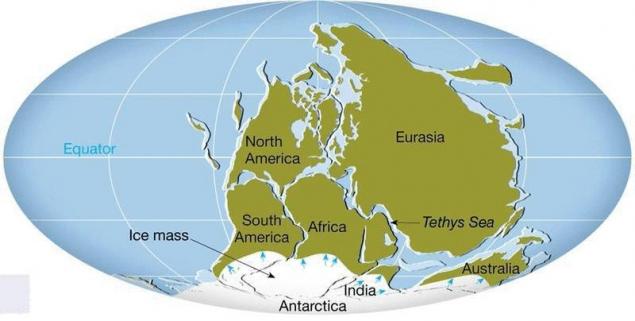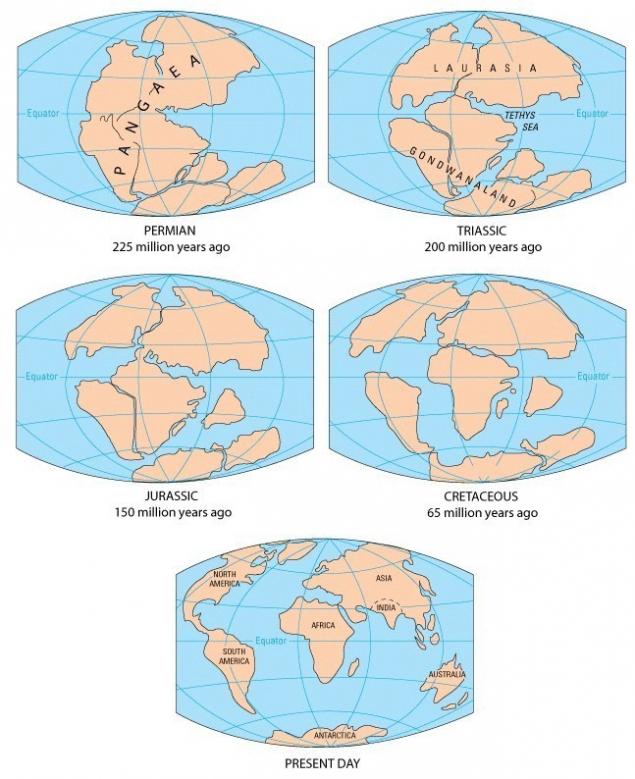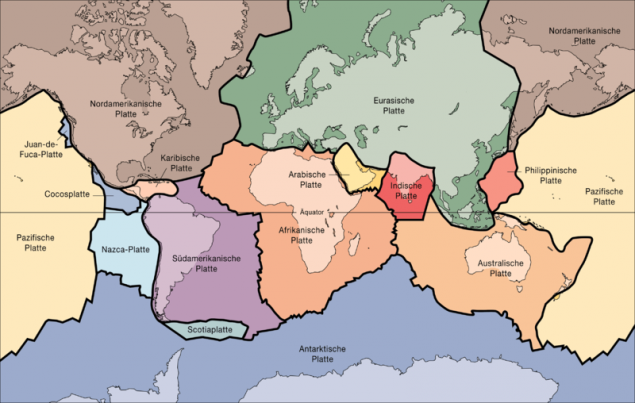Habitat: why on the planet five populated continents
 Bashny.Net
Bashny.Net
Now on our planet 5 inhabited continents: Africa, Eurasia, Australia, North America and South America — and one desert: Antarctica. Eurasia is divided into two parts of light; the border between them is the Ural mountains, then the river Emba to the Caspian sea and North Caucasus along the rivers Kuma and Manych to the sea of Azov, and then — on the Black and Mediterranean seas (so Turkey is in Asia, although its territory extends the same Meridian, and on the territory of Norway, Finland and Ukraine — 30 minutes).

It is believed that about 200 million years ago on Earth there was a single continent — Pangaea, surrounded by a single ocean. Part of Pangaea consisted of all the modern continents, but then the continent split in half, and there was Laurasia (including North America and much of Eurasia) and Gondwana (composed of Africa, South America, the Indian subcontinent, Australia and Antarctica). After that, the continents continued to spread in different directions under the action of tectonic forces and broken into pieces, causing the world to take recognizable shape. They continue their movement, and approximately 200 million years, probably get back together in one supercontinent, a New Pangaea.

Today on our planet 14 lithospheric plates: Eurasian, North American, Australian, Philippine, Pacific plate, Juan de Fuca, Cocos, Nazca, South American, Scotia, African, Arabian, Indian and Antarctic. Half plates: Juan de Fuca, Cocos, Nazca, Scotia, Philippine, Arabian and Indian — are small in size.
The inner part of the Earth practically inaccessible to humans, but the technique, experiments and working with models allowed us to "feel" their planet to its core and create the theory of plate tectonics, which explains what is happening with the terrain on land and under water. Rigid lithospheric plates all the time "creep" on a hot mantle of the planet, and with them moves the bottom of the oceans and continents. The bottom is continuously created along the mid-oceanic ridges — a network of volcanic mountain ranges with a length of almost two equator (over 70,000 km), lying in the Central parts of all oceans. But despite the fact that the hot core continuously pushes the rock, the Earth is not increasing in size. This is because the edges of the plates, the breed is destroyed in the depressions, the so — called subduction zones and descends again inside the planet. It is clearly seen, for example, in the case of the Pacific plate. Ring of fire on its edges — the volcanoes of Kamchatka, the Japanese Islands, New Zealand, Antarctica, Tierra del Fuego, the South American Andes, North American Cordillera and Alaska — these areas of decay.
The continents also change all the time, and today we know that different sections were formed in different time intervals. The mountain chain collapse and eventually turn into a plain, on the border of contact of the lithospheric plates grow new ridges.
"Today, all the oceans: Atlantic, Pacific, Indian and Arctic — revealed - says Professor Nicholas Koronovskii, head of the Department of dynamic Geology geological faculty, Moscow state University. M. V. Lomonosov and the Department of ecology and Earth Sciences, international University "Dubna". — Magma rises at mid-ocean ridges; the paradigm of plate tectonics. Oceans before revealed, and then, perhaps, going together, and will arise again Pangaea, 200 million years ago. To say, when that happens, difficult because the movement speed from different continents: Australia, quickly runs to the North, and Antarctica is in place. Australia is shifted by 15 cm per year, Atlantic revealed by 6-7 cm per year, and Arabia along with Africa moving North at 2 cm per year, and it's a bit. The perimeter of the Pacific ocean: the Aleutian arc, Kamchatka, the Kuril Islands, Japan is a subduction zone, the dip of the heavy oceanic plates beneath lighter continental. Because of this, there appear volcanism and earthquakes. No wonder there is the Pacific ring of fire.
If the movement of plates cyclically, we're in the middle of the cycle. But it's hard to tell. Their movement may accelerate and may slow down. It all depends on how is the movement in the mantle. And they occur at a speed of 1-2 cm per year. However, if the process continues, 100 million years, all the movements are felt".published
P. S. And remember, only by changing their consumption — together we change the world! ©
Source: theoryandpractice.ru

It is believed that about 200 million years ago on Earth there was a single continent — Pangaea, surrounded by a single ocean. Part of Pangaea consisted of all the modern continents, but then the continent split in half, and there was Laurasia (including North America and much of Eurasia) and Gondwana (composed of Africa, South America, the Indian subcontinent, Australia and Antarctica). After that, the continents continued to spread in different directions under the action of tectonic forces and broken into pieces, causing the world to take recognizable shape. They continue their movement, and approximately 200 million years, probably get back together in one supercontinent, a New Pangaea.

Today on our planet 14 lithospheric plates: Eurasian, North American, Australian, Philippine, Pacific plate, Juan de Fuca, Cocos, Nazca, South American, Scotia, African, Arabian, Indian and Antarctic. Half plates: Juan de Fuca, Cocos, Nazca, Scotia, Philippine, Arabian and Indian — are small in size.

The inner part of the Earth practically inaccessible to humans, but the technique, experiments and working with models allowed us to "feel" their planet to its core and create the theory of plate tectonics, which explains what is happening with the terrain on land and under water. Rigid lithospheric plates all the time "creep" on a hot mantle of the planet, and with them moves the bottom of the oceans and continents. The bottom is continuously created along the mid-oceanic ridges — a network of volcanic mountain ranges with a length of almost two equator (over 70,000 km), lying in the Central parts of all oceans. But despite the fact that the hot core continuously pushes the rock, the Earth is not increasing in size. This is because the edges of the plates, the breed is destroyed in the depressions, the so — called subduction zones and descends again inside the planet. It is clearly seen, for example, in the case of the Pacific plate. Ring of fire on its edges — the volcanoes of Kamchatka, the Japanese Islands, New Zealand, Antarctica, Tierra del Fuego, the South American Andes, North American Cordillera and Alaska — these areas of decay.
The continents also change all the time, and today we know that different sections were formed in different time intervals. The mountain chain collapse and eventually turn into a plain, on the border of contact of the lithospheric plates grow new ridges.
"Today, all the oceans: Atlantic, Pacific, Indian and Arctic — revealed - says Professor Nicholas Koronovskii, head of the Department of dynamic Geology geological faculty, Moscow state University. M. V. Lomonosov and the Department of ecology and Earth Sciences, international University "Dubna". — Magma rises at mid-ocean ridges; the paradigm of plate tectonics. Oceans before revealed, and then, perhaps, going together, and will arise again Pangaea, 200 million years ago. To say, when that happens, difficult because the movement speed from different continents: Australia, quickly runs to the North, and Antarctica is in place. Australia is shifted by 15 cm per year, Atlantic revealed by 6-7 cm per year, and Arabia along with Africa moving North at 2 cm per year, and it's a bit. The perimeter of the Pacific ocean: the Aleutian arc, Kamchatka, the Kuril Islands, Japan is a subduction zone, the dip of the heavy oceanic plates beneath lighter continental. Because of this, there appear volcanism and earthquakes. No wonder there is the Pacific ring of fire.
If the movement of plates cyclically, we're in the middle of the cycle. But it's hard to tell. Their movement may accelerate and may slow down. It all depends on how is the movement in the mantle. And they occur at a speed of 1-2 cm per year. However, if the process continues, 100 million years, all the movements are felt".published
P. S. And remember, only by changing their consumption — together we change the world! ©
Source: theoryandpractice.ru
Tags
See also
No, a great human lifespan will not destroy our planet
Mysterious and frightening places of our planet (11 photos)
Top 10 most polluted places on the planet
10 places of the world in which you never pop
Facts about the most amazing places on our planet
10 worst places for civilized life on our planet
Strange and rare animals on our planet
Space landscape of our planet
10 amazing secrets of the world that science finally revealed
10 secrets of our planet, which science finally revealed
















